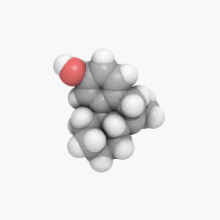Dekstrorfan
Prijeđi na navigaciju
Prijeđi na pretragu

| |||

| |||
| (IUPAC) ime | |||
|---|---|---|---|
| (+)-17-methyl- 9a,13a,14a-morphinan- 3-ol | |||
| Klinički podaci | |||
| Identifikatori | |||
| CAS broj | 125-73-5 | ||
| ATC kod | nije dodeljen | ||
| PubChem[1][2] | 5360697 | ||
| Hemijski podaci | |||
| Formula | C17H23NO | ||
| Mol. masa | 257.371 g/mol | ||
| |||
| Farmakoinformacioni podaci | |||
| Trudnoća | ? | ||
| Pravni status | OTC (SAD) | ||
Dekstrorfan (DXO) je psihoaktivni lek iz morfinanske hemijske klase koji deluje kao antitusivni lek (supresant kašlja) i disocijativni halucinogen. On je dekstro-stereoizomer racemorfana, gde je leva-polovina levorfanol. Dekstrorfan se proizvodi O-demetilacijom dekstrometorfana CYP2D6-om. Dekstrorfan je NMDA antagonist i doprinosi riziku zloupotrebe dekstrometorfana.[3]
Farmakologija[uredi | uredi kod]
- Nekompetitivni antagonist N-metil-D-aspartatnog receptora (NMDAR).[4][5][6]
- Agonist σ1 i σ2 sigma receptora.[7][8]
- Antagonist α3β4, α4β2, i α7 nikotinskog acetilholinskog receptora.[9][10]
- Bloker L-tip naponom-kontrolisanog kalcijumskog kanala (LVGCC).[6][11]
Literatura[uredi | uredi kod]
- ↑ Li Q, Cheng T, Wang Y, Bryant SH (2010). „PubChem as a public resource for drug discovery.”. Drug Discov Today 15 (23-24): 1052-7. DOI:10.1016/j.drudis.2010.10.003. PMID 20970519.
- ↑ Evan E. Bolton, Yanli Wang, Paul A. Thiessen, Stephen H. Bryant (2008). „Chapter 12 PubChem: Integrated Platform of Small Molecules and Biological Activities”. Annual Reports in Computational Chemistry 4: 217-241. DOI:10.1016/S1574-1400(08)00012-1.
- ↑ Zawertailo LA, Kaplan HL, Busto UE, Tyndale RF, Sellers EM (August 1998). „Psychotropic effects of dextromethorphan are altered by the CYP2D6 polymorphism: a pilot study”. Journal of clinical psychopharmacology 18 (4): 332–7. PMID 9690700.
- ↑ Wong BY, Coulter DA, Choi DW, Prince DA (February 1988). „Dextrorphan and dextromethorphan, common antitussives, are antiepileptic and antagonize N-methyl-D-aspartate in brain slices”. Neuroscience Letters 85 (2): 261–6. DOI:10.1016/0304-3940(88)90362-X. PMID 2897648.
- ↑ Church J, Jones MG, Davies SN, Lodge D (June 1989). „Antitussive agents as N-methylaspartate antagonists: further studies”. Canadian Journal of Physiology and Pharmacology 67 (6): 561–7. PMID 2673498.
- ↑ 6,0 6,1 Kamel IR, Wendling WW, Chen D, Wendling KS, Harakal C, Carlsson C (October 2008). „N-methyl-D-aspartate (NMDA) antagonists--S(+)-ketamine, dextrorphan, and dextromethorphan--act as calcium antagonists on bovine cerebral arteries”. Journal of Neurosurgical Anesthesiology 20 (4): 241–8. DOI:10.1097/ANA.0b013e31817f523f. PMID 18812887. Arhivirano iz originala na datum 2011-07-18. Pristupljeno 2014-04-05.
- ↑ Richter A, Löscher W (January 1997). „Dextrorphan, but not dextromethorphan, exerts weak antidystonic effects in mutant dystonic hamsters”. Brain Research 745 (1-2): 336–8. DOI:10.1016/S0006-8993(96)01254-1. PMID 9037429.
- ↑ Chou YC, Liao JF, Chang WY, Lin MF, Chen CF (March 1999). „Binding of dimemorfan to sigma-1 receptor and its anticonvulsant and locomotor effects in mice, compared with dextromethorphan and dextrorphan”. Brain Research 821 (2): 516–9. DOI:10.1016/S0006-8993(99)01125-7. PMID 10064839.
- ↑ Damaj MI, Flood P, Ho KK, May EL, Martin BR (February 2005). „Effect of dextrometorphan and dextrorphan on nicotine and neuronal nicotinic receptors: in vitro and in vivo selectivity”. The Journal of Pharmacology and Experimental Therapeutics 312 (2): 780–5. DOI:10.1124/jpet.104.075093. PMID 15356218.
- ↑ Hernandez SC, Bertolino M, Xiao Y, Pringle KE, Caruso FS, Kellar KJ (2000). „Dextromethorphan and its metabolite dextrorphan block alpha3beta4 neuronal nicotinic receptors”. J. Pharmacol. Exp. Ther. 293 (3): 962–7. PMID 10869398.
- ↑ Kim HC, Ko KH, Kim WK, et al. (May 2001). „Effects of dextromethorphan on the seizures induced by kainate and the calcium channel agonist BAY k-8644: comparison with the effects of dextrorphan”. Behavioural Brain Research 120 (2): 169–75. DOI:10.1016/S0166-4328(00)00372-7. PMID 11182165.